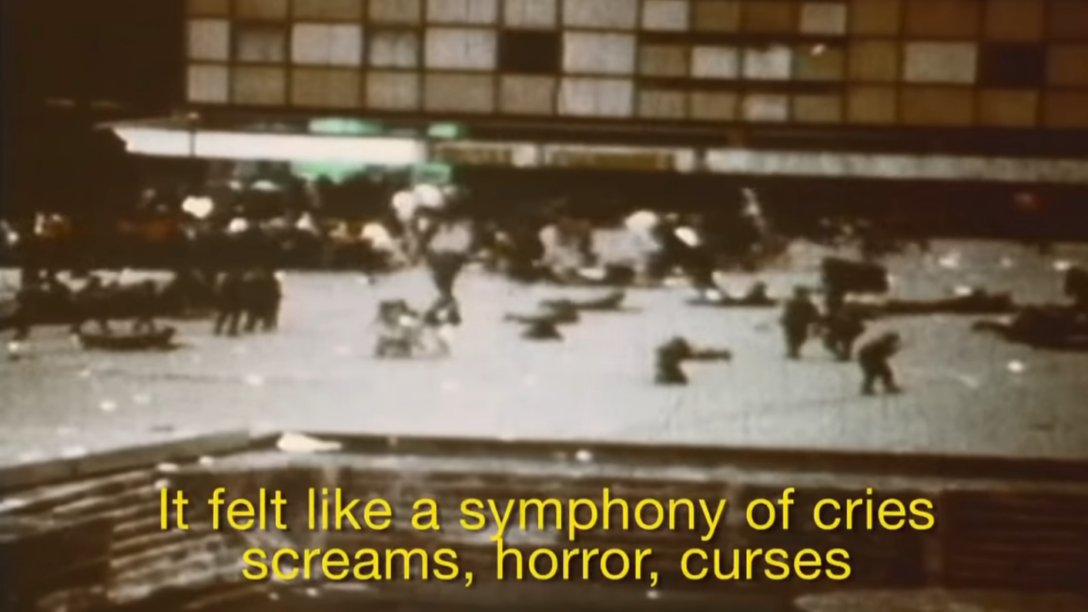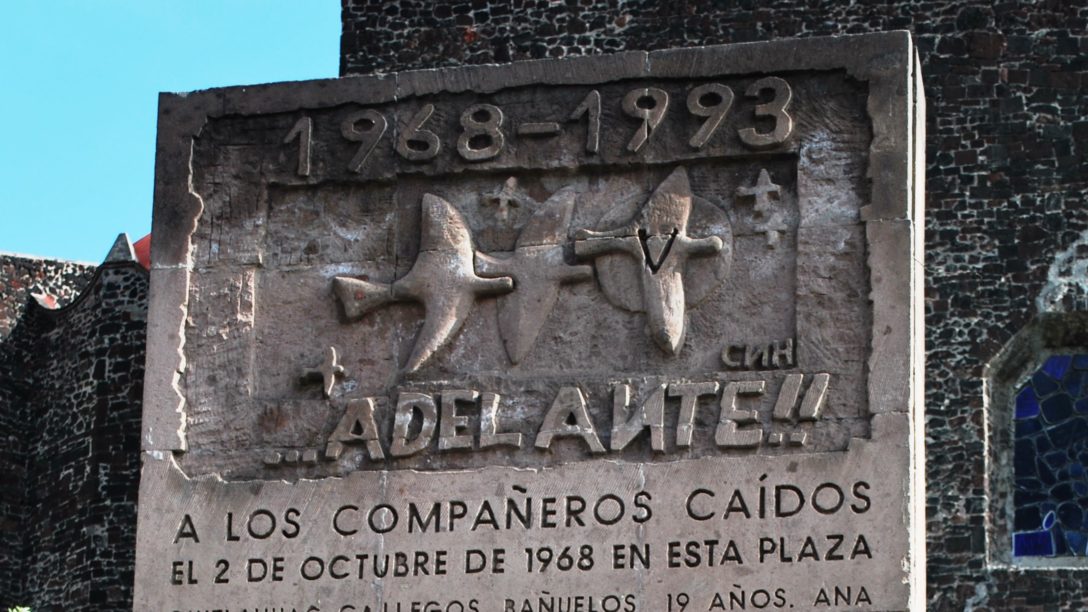Under a cloudy sky, the first bullets rained from one of the residential towers.
An emergency flare lit from the roof of the church (or was it from the helicopter circling overhead?) gave the green light to the snipers in place above the Plaza de las Tres Culturas in Tlatelolco. Poised on the podium one of the leaders, known as El Pelón Vega—a prematurely bald engineering student from the Polytechnic Institute—didn’t get to finish his speech.[i] With clenched jaws his comrades urged him: “Hurry up and let’s go.” But the massacre had already begun.
The mass of protesters tossed like a centrifugal whirlpool. Some scrambled west towards the underpass, others ducked into the archeological site, dodging shots among ancestral burial grounds. Toward the east the cement columns of the housing units and the ground floor terraces provided the only reliable cover in an otherwise pierceable plastic building.
The goons from the battalion squads that had infiltrated the crowd were clothed in civilian garb, distinguished in the multitude by a white glove on the left hand. The right hand held a loaded gun.
Before the tanks began bulldozing the protesters, they blocked the exit routes. They were shooting into a barrel, over and over again.
“Now we’ll give you your revolution, fucking sons of bitches!”[ii]
Today the façade of the Hilton Hotel on Avenida Reforma is barricaded with a ten-foot metal wall. As is the marble of the Palace of Bellas Artes; as are fountains and pillars and statues in the gardens bordering Avenida Juarez. Calle Madero is completely blocked off.
The mayor said there would be no police presence around the commemoratory march this year. The twelve thousand officers deployed would be unarmed. The city would not knuckle under to provocations by masked protesters.
The president’s view is that the black bloc is just a bunch of ganged-up reactionaries funded by the opposition. His most serious punitive commitment was to tattle against its members to their parents and grandparents.
The head of the National Chamber of the Restaurant Industry alleged that the infrastructure damage and business losses from last week’s protest for the 43 forcibly disappeared students amounted to over 100 million pesos.
Hurried graffiti pre-emptively read: 2 de octubre, no se olvida. October 2nd is not forgotten. The common refrain multiplied all over—call it the “national conscience”—so the fresh coats of white-out, solvents, and brushing proved useless.
From the speakers loaded on the back of a pick-up truck, a choked voice moaned, “We thought we had a promise, to never face 1968 again.”
In the final section of The Differend, “The Sign of History”, Jean-Francois Lyotard writes that any contemporary reflection on historico-political reality inevitably runs up against the issue of proper names—breadcrumbs in a line out of some dark woods, wispy points of reference for the present to which we either owe a great deal in epistemological value, or which we resent for obfuscating alternative re-tellings.
The proper names he refers to—Auschwitz, Budapest ’56, Nineteen-sixty-eight—suspend political and historical commentary. The circumstances from which the events emerged, those eventually maturing into deep, untreatable incisions, not only generate a void for words; the names themselves “invalidate the supposition” of the means to comment on events within a plurality of canons—philosophical, rational, materialist.[iii]
But what the fuck would Lyotard know about Tlatelolco?
The day before the massacre, student leaders greeted each other with a bluff. To show their courage they flashed shiny high-caliber handguns. The instinct for self-defense was prescient. But twenty years later, Gilberto Guevara Niebla—an activist from one of the science departments at the UNAM—recounted that he was certain that no one had ever shot one of those before, nor would have even known how to.[iv] As a child he’d gone hunting with his father and used a 0.22 rifle. But never a handgun.
Around 6:00 pm on the night of the rally—as he hid from the constant fire in a room on the fifth floor of the Chihuahua building, watching the floors slowly flood as punctured pipes and water tanks leaked, debating whether to destroy his ID card and choosing instead to conceal it in a small orifice of the external wall where he would later retrieve it from the tenant of the housing unit, and mentally preparing himself to give a false name upon his eventual arrest—Guevara described the minutes of the massacre transpired as endless. Past and future blurred.
 Screenshot: YouTube
Screenshot: YouTubeAfter the beatings, his sternum—fractured with the butt of a gun by a light-haired soldier—healed incorrectly. In Paris, the doctor Guevara visited when he could no longer bear the discomfort told him that there was nothing he could do. The pain never subsided.
On September 26, 2014—43 students in the state of Guerrero mobilized in advance of the anniversary of the student massacre in Tlatelolco. While commandeering a fleet of buses headed towards Mexico City, police and other law enforcement set roadblocks and fired live ammunition, attempting to stop them. Eventually, witnesses claim, they did. The students that couldn’t escape were rounded up, killed, and dipped in acid to destroy whatever remained of them.
No, they were handed over to members of the cartel Guerreros Unidos and it is unclear what happened next.
No, they suffocated in crammed federal police vehicles and were later burnt in a dumpster.
No, their ashes were thrown into the river.
Without a doubt, it was the state who did it.
Before 4 o’ clock, I caught a north-bound train on line 3 from campus to join the protest.
At each transfer station a row of cops and volunteer government officials in white shirts bearing the now-state-sanctioned slogan “2 de octubre, no se olvida” cordoned off entry into the last subway cars. The last few yards of the platform were packed to the brim with students waving signs and flags, chanting: Ni perdón, ni olvido. Not forgiveness, nor oblivion.
Past the turnstiles above ground, the air tasted like metal, heavy with paint; tags on the pavement and the walls led those newly arrived towards the junction of Eje 1 and Avenida Flores Magón.
Beneath the pedestrian bridge a thin figure clad all in black, face covered, labored over a silk screen, dousing it with blood-red liquid and handing off prints in all directions. A sign read: The police only show up when it’s a matter of suppressing the people. Someone asked for a selfie. The march creaked slowly into motion, its muscle memory flexing, 51 years in the game.
An older woman with a voice like asphalt dashed ahead, attempting to jostle with members of the black bloc.
“Go paint your houses instead if you’re so eager to paint!”
A small crowd of pre-teens formed around her; maybe it would be the biggest Instagram story of the week.
The cosmopolitan city of Tlatelolco—founded by defectors from the Aztec empire in the 15th century—was the last site of resistance before Cuauhtémoc was forced to capitulate to Hernan Cortes in 1521.
After one of the bloodiest genocidal battles waged against the native peoples, their ceremonial site was sacked and destroyed, and the stones of the pyramids used to erect the Catholic Temple of Santiago. A similar rite was carried out in the construction of the Metropolitan Cathedral, raised on the most sacred precinct for the Tenochca people, the Templo Mayor.
When in 1959, the construction of a massive housing development began on the same site, the builders were ordered to destroy all the artifacts superseding a 500-meter radius, so as to not inhibit deep digging nor the installation of plumbing infrastructure. Mario Pani, the project’s lead architect, waged that “there were already so many pyramids in Mexico…destroying or covering those in Tlatelolco means no harm.”[v]
Commenting on the site’s history and future plans, Francisco Gonzalez Rul, head archeologist, went a step further:
“In time, Santiago de Tlaltelolco lost more and more of its importance until it became a dirty and unattractive suburb, the seat of army barracks, prisons, store-houses and factories. Today, like the old gods, technicians are going to create a new Cosmogonic Sun with the buried remains of the past and the blood of the new nation…Tlatelolco will be in the near future, the synthesis of pre-hispanic [sic] cultures, of the first phase of the Colonial Period and of our time.”
So many artifacts were dug up that even those who originally dismissed the preservation efforts realized that they would not be able to escape public scrutiny. The plans changed. Instead of razing indiscriminately, they built a narrative. A monumental square took shape. Molding and preserving in literal layers, the square ascended in discrete planes: at the bottom, ancient sacrificial pyramids; above these, a Spanish colonial church dedicated to Santiago; at street-level, the beaming, geometric, and chromatically austere modernist towers: the material underpinnings of a general process of national modernization; a crude syncretic promise that some of the tainted past could be taken into the future.
A commemorative plaque was fittingly plastered on the southwest corner. Today it still reads:
HEROICALLY DEFENDED BY
CUAUHTEMOC
TLATELOLCO FELL BY THE POWER OF
HERNAN CORTES
IT WAS NOT A TRIUMPH NOR A DEFEAT
IT WAS THE PAINFUL BIRTH OF THE
MESTIZO PEOPLE
THAT IS THE MEXICO OF TODAY
On October 2, 1968, thousands of students, workers, and residents gathered at the square to demand an end to political repression ahead of Mexico’s first Olympic Games—an affair with a nearly $1 billion-dollar price-tag.[vi] Despite the vigilant eye of the international media, military tanks shot and bulldozed the dissenters.
By morning their bodies were cleared, the blood scrubbed from the ground. The games occurred as planned. In a declassified memo from the US State Department, officials remarked that the PRI party in power would still be a vehicle for national prosperity.[vii]
Other observers regarded the event as the end of a façade—the moment when the violence and censorship that characterized Mexico under the single-party rule of the PRI were put on full display.[viii] The country’s attempt to project revolution and modernity outwardly bore its false fruit in the repression of its citizens.
Pace Lyotard, Tlatelolco is a name that produces more questions than answers; it remains a testimony to the failed utopias that the massacre of 1968 notarized. One is not urged to forget the name Tlatelolco, nor to restore the discourse that gave credence to the possible project of modernity.

[i] González de Alba, Luis. “Tlatelolco aquella tarde”, Nexos. November 1, 2016. https://www.nexos.com.mx/?p=30019
[ii] Ibid. Spanish Original: “¡Ahora les vamos a dar su revolución, hijos de su puta madre!” (All translations are by the autor.)
[iii] Lyotard, Jean-Francois. “The Sign of History”, The Lyotard Reader. Andrew Benjamin, ed. Basil Blackwell. Cambridge, MA, 1991.
[iv] Guevara Niebla, Gilberto. “Volver a Tlatelolco”, Nexos. October 1, 1983. https://www.nexos.com.mx/?p=6899
[v] González Rul, Francisco. Spanish: Urbanismo y arquitectura en Tlatelolco. Mexico. INAH. 1998. p. 123 in Márez Tapia, Miguel Ángel. Spanish: “Tlatelolco a través de sus objetos: entre la modernidad y el patrimonio cultural”, Antropología. n.d. p. 60.
[vi] Mexico, 1968. Olympic Games Committee. http://www.com.org.mx/ciclo-olimpico/mexico-1968/
[vii] Tlatelolco Massacre, U.S. Documents on Mexico and the Events of 1968. Kate Doyle, ed. The National Security Archive. https://nsarchive2.gwu.edu/NSAEBB/NSAEBB99/
[viii] Booth, William. “1968: An End and a Beginning for Mexico”, Verso, June 15, 2018. https://www.versobooks.com/blogs/3884-1968-an-end-and-a-beginning-for-mexico







